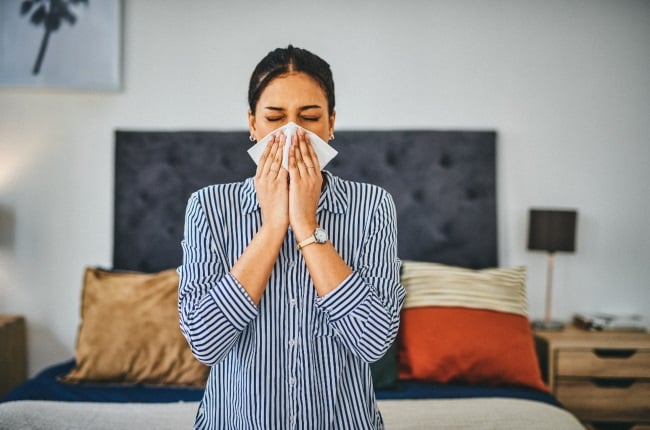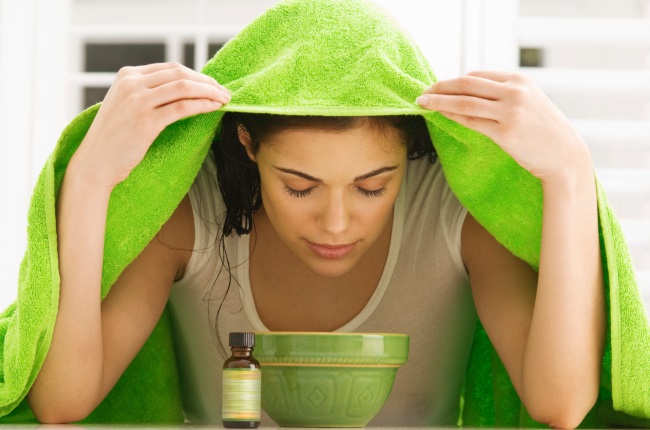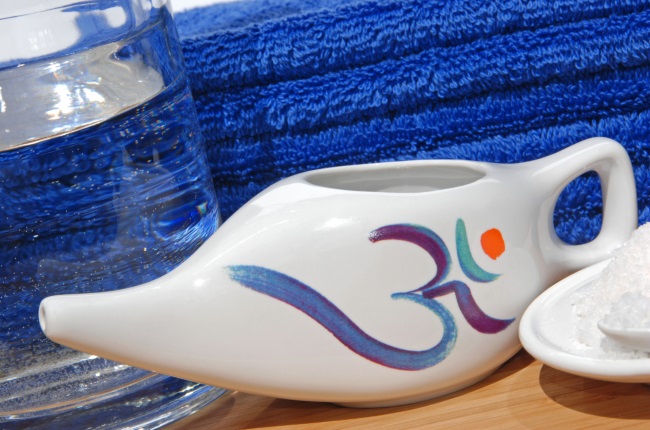
Sniffling, a runny nose, constant wiping that leaves the skin on the sides of your nose red and tender . . . nasal congestion can really take the fun out of life.
“A blocked nose affects our ability to breathe, sleep, exercise and eat,” says Australian ear, nose and throat specialist Dr Benjamin Cook.
“The main causes are viral upper respiratory infections like colds and flu, allergies and problems with the structure of the nose.”
Here’s a look at the main reasons for a stuffy nose and what you can do about them.
COLDS
Colds cause a stuffy nose by eliciting an immune response which causes the lining of the nose to swell and secrete excess mucus. The nose is trying to clean and protect itself but the trade-off is the sensation of blockage and a runny nose.
What to do The best treatments are saline sprays or rinses to help clean the nose, followed by short-term use of decongestants such as oxymetazoline sprays and tablets containing phenylephrine. These medications shrink the blood vessels in the nose, allowing easier breathing.
Steam (with or without eucalyptus) can be useful, particularly if there’s a related dry throat or cough. Breathing humidified air helps the lungs receive air that would ordinarily be warmed by a normally functioning nose.
Note Some decongestants can raise blood pressure so use with caution.
HAY FEVER
Hay fever is a seasonal allergic disorder characterised by sneezing, itchy eyes and a runny, blocked nose. It tends to occur in those who have an allergic predisposition and usually in spring when grass pollens are in the air. Pollens cause a histamine release in the lining of the nasal cavity. Histamine then causes the lining to swell and the airflow through the nose is reduced.
What to do Simple avoidance of the reaction-causing substances may be effective, and saline sprays can help clean the nose and reduce the concentration of pollen. If simple measures fail, antihistamine tablets often work well. Other treatments include steroid nasal sprays, which block the allergic reaction, or alternative therapies such as acupuncture and herbal remedies, which have been used to fight hay fever for centuries.
Note Some herbal treatments can make allergies worse. Consult your GP before trying a new treatment.
OTHER ALLERGIES
Allergies to dust mites, animal hair and various moulds and fungi are common causes of a stuffy nose. Dust mite allergy is common and is a reaction to the waste product of the mites that feed on dead skin cells.
Other irritants such as perfumes, cleaning products and cigarette smoke can all trigger nasal inflammation and obstruction.
What to do Look at your home environment. It may help to steam-clean carpets and use hypoallergenic bedding. Replacing thick carpets with floorboards is sometimes necessary to reduce dust mites. If you’re allergic to cats and dogs, avoid them where possible.
Antihistamines are another treatment, as is desensitisation – a process where a person receives a tiny quantity of an allergen (usually in tablet form) to train the immune system to be tolerant of the substance and stop it reacting with allergy symptoms.
SINUSITIS
Sinusitis is an infection and/or inflammation of the nasal sinuses. Sinuses are air-filled chambers behind the cheeks, above the brow and between the eyes. These chambers are usually kept sterile by the constant cleaning action of microscopic hairs that line their surface.
Viral infections can affect this “sinus filter” and allow bacteria in. Together with the excess mucus from the nose and sinuses, the bacteria multiply and pressure builds up, causing facial pain and a yellow/green discharge. This discharge is essentially your own immune cells spilling into your nose.
What to do The best ways to treat sinusitis early on include saline rinses or sprays, and decongestants. Saline rinses, either using a squeeze bottle or a neti pot, are also helpful. These have been used in Asian cultures for centuries for the treatment of sinus conditions.
Sleeping with your head elevated and using a humidifier in the bedroom is also recommended. Inhaling hot steam with or without eucalyptus can help moisten the nose and clear those blocked nasal passages.
If the infection persists beyond a few days you may need antibiotics or even the anti-inflammatory medicine prednisolone, which will need to be prescribed by your GP. If your symptoms last for more than a few weeks, a visit to an ear, nose and throat (ENT) specialist may be necessary.
You’re pregnant
Up to 30% of pregnant women experience nasal stuffiness. Extra oestrogen causes fluid retention in the lining of the nose and can dilate the blood vessels, restricting airflow. Sinusitis is also more common during pregnancy. Safe treatments include saline and steam inhalations, and elevation of the head while sleeping.
You had too much to drink
Alcohol can cause nasal obstruction. Red wine in particular causes the nasal lining to swell, blocking airflow.
You’re a smoker
Cigarette smoking reduces the ability of the nose to clean itself leading to obstruction. The only treatment? Quit smoking.
STRUCTURAL PROBLEMS
Always sniffling? It might be because of the way your nose was formed.
Structural problems associated with a stuffy nose include deviation of the wall partitioning the nose (nasal septum), enlarged turbinates (bony structures on either side of the nose that regulate the humidity and airflow) and enlarged adenoids (a lump of lymph gland tissue situated at the back of the nose).
What to do Unfortunately, surgery is the only effective way to correct structural problems. Deviated septums can be corrected with a septoplasty, enlarged turbinates can be trimmed using a variety of techniques, while enlarged adenoids are usually removed through the mouth.
READ MORE| Are you as healthy as you think? Take our test to find your best food and drink options
Nasal surgical procedures are done under general an aesthetic− and most can be done as a day procedure.
Consult your GP who will refer you to an ENT specialist for diagnosis and treatment.
SOURCE: AREMEDIASYNDICATION.COM.AU/MAGAZINEFEATURES.CO.ZA




 Publications
Publications
 Partners
Partners



















